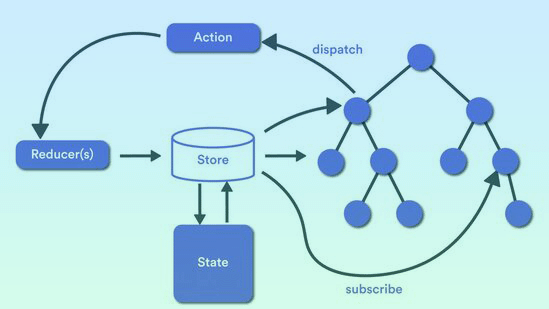In this article you will get proper insight of the ” Top libraries for state management in react native “. This article will help you choose one and also introduce you with them, along with coding example, so that you can get proper insight of them.
Introduction
In the rapidly evolving sphere of mobile app development, React Native has emerged as a dominant player, renowned for its cross-platform capabilities and efficient UI building blocks. This article delves deep into the top-tier libraries for state management in React Native, offering streamlined development processes and empowering developers to craft robust, responsive applications. From overseeing global state to the local state handling, these libraries offer a spectrum of solutions tailored to match the unique demands of your projects.
Check for “scenario based recommendations” at the bottom of the article to understand which library is best to use when.

Getting Started: Setting Up Your React Native Project
To start using this feature, you need a React Native project up and running. If you don’t have one, here’s a quick overview of setting it up:
- Install Node.js: Ensure you have Node.js installed on your system. You can download it from the official website.
- Install React Native CLI or Expo: If you haven’t installed yet, follow the post, create new project.
Top Libraries for State Management in React Native
MobX:
MobX, the dynamic state management library in react native, empowers developers to create applications that are both reactive and scalable, ensuring maintainability over time. At the core of MobX lies the concept of observables, allowing state synchronization with the user interface.
To illustrate, let’s consider a scenario in which we’re developing a real-time collaboration app. MobX ensures that changes in the shared document are instantly reflected on the screens of all participants.
import { makeObservable, observable, action } from "mobx";
class DocumentStore {
@observable content = "";
constructor() {
makeObservable(this);
}
@action updateContent(newContent) {
this.content = newContent;
}
}
const docStore = new DocumentStore();
Redux:
Redux stands as a cornerstone within the React ecosystem, offering a predictable state management approach. In Redux, actions trigger state changes through reducers, providing a structured data flow. It follows the flux pattern, where actions trigger state changes via reducers. Redux is well-suited for complex apps with a multitude of interconnected components. Imagine a project management tool where tasks, deadlines, and team member assignments dynamically update. Redux ensures that every component seamlessly accesses and updates the global state.
Consider a scenario where we’re building a shopping app. Redux ensures that the shopping cart state is centrally managed and consistent across various components.
import { createStore } from "redux";
const cartReducer = (state = [], action) => {
switch (action.type) {
case "ADD_TO_CART":
return [...state, action.payload];
case "REMOVE_FROM_CART":
return state.filter(item => item.id !== action.payload.id);
default:
return state;
}
};
const store = createStore(cartReducer);
Zustand:
Zustand takes a minimalist approach to state management in react native, offering a streamlined API. This library is an excellent fit for smaller projects where simplicity is crucial. It is an excellent choice for smaller projects or scenarios where simplicity is paramount. Consider a weather widget within a news app. Zustand simplifies the process of managing weather data, allowing developers to focus on the core functionality of the widget without being burdened by extensive setup.
Imagine a scenario where we’re building a weather app. Zustand allows us to manage weather data without overcomplicating the setup.
import create from "zustand";
const useWeatherStore = create((set) => ({
temperature: "",
updateTemperature: (newTemp) => set({ temperature: newTemp }),
}));
function WeatherApp() {
const { temperature, updateTemperature } = useWeatherStore();
return (
<div>
<p>Current Temperature: {temperature}</p>
<button onClick={() => updateTemperature("25°C")}>
Update Temperature
</button>
</div>
);
}
Recoil:
Recoil, developed by Facebook, specializes in managing asynchronous data and minimizing unnecessary re-renders. It excels in scenarios requiring real-time data updates. It’s ideal for applications dealing with real-time data updates. For example, in a live sports score app, Recoil can manage scores, player statistics, and updates from ongoing matches. Recoil’s atom concept ensures that relevant components receive real-time data updates without causing undue re-renders.
Imagine a chat application where messages arrive in real-time. Recoil ensures that new messages are seamlessly integrated into the conversation without causing unnecessary UI updates.
import { atom, RecoilRoot, useRecoilState } from "recoil";
const messagesState = atom({
key: "messagesState",
default: [],
});
function ChatApp() {
const [messages, setMessages] = useRecoilState(messagesState);
const receiveMessage = (newMessage) => {
setMessages((prevMessages) => [...prevMessages, newMessage]);
};
return (
<div>
{messages.map((message, index) => (
<p key={index}>{message}</p>
))}
</div>
);
}
Mobius:
Mobius embraces functional reactive programming (FRP) principles, offering separation between state and effects. This makes testing and debugging seamless. Mobius is suitable for scenarios where event-driven architectures are prevalent. Consider a stock trading app that requires instant updates on stock prices. Mobius streamlines the process of handling price updates while maintaining a clear separation between state and UI effects.
Consider an app tracking stock prices. Mobius ensures smooth state management while allowing us to focus on the business logic.
import { createSignal, onCleanup } from "solid-js";
function StockPriceApp() {
const [price, setPrice] = createSignal(0);
const updatePrice = () => {
// Simulate fetching new price
setPrice(Math.random() * 100);
};
// Cleanup on component unmount
onCleanup(() => clearInterval(priceInterval));
const priceInterval = setInterval(updatePrice, 5000);
return (
<div>
<p>Current Price: ${price()}</p>
</div>
);
}
Easy Peasy:
Easy Peasy strikes a balance between simplicity and structured state management, making it suitable for apps with moderate complexity. It strikes a balance between the simplicity of Zustand and the predictability of Redux. Easy Peasy is advantageous when developing apps with a moderate complexity level. An e-commerce app, for instance, could utilize Easy Peasy to manage shopping cart state and user preferences efficiently.
Imagine a blogging app where you need to manage both user authentication and blog post data.
import { createStore, action } from "easy-peasy";
const store = createStore({
isAuthenticated: false,
user: {},
blogPosts: [],
toggleAuth: action((state) => {
state.isAuthenticated = !state.isAuthenticated;
}),
updateUser: action((state, payload) => {
state.user = payload;
}),
addBlogPost: action((state, payload) => {
state.blogPosts.push(payload);
}),
});
Jotai:
Jotai introduces atomic state units known as “atoms,” facilitating state sharing across components. This library shines in scenarios where modular and atomic state management is critical. Think of a note-taking app where multiple notes are created, edited, and deleted. Jotai can manage individual note states and ensure that updates to one note do not interfere with others.
Consider a to-do list app where each task is an atomic unit of state managed by Jotai.
import { atom, useAtom } from "jotai";
const tasksAtom = atom([]);
function ToDoApp() {
const [tasks, setTasks] = useAtom(tasksAtom);
const addTask = (newTask) => {
setTasks((prevTasks) => [...prevTasks, newTask]);
};
return (
<div>
<ul>
{tasks.map((task, index) => (
<li key={index}>{task}</li>
))}
</ul>
<button onClick={() => addTask("New Task")}>Add Task</button>
</div>
);
}
Scenario-based Recommendations
- Real-time Collaboration App: MobX excels in scenarios where real-time synchronization is crucial, ensuring instant updates across participants.
- Large-scale E-commerce App: Redux’s structured approach suits complex apps with numerous interconnected components, maintaining a consistent shopping cart state.
- Weather App: Zustand is an apt choice for smaller projects like a weather app, offering simplicity without compromising functionality.
- Real-time Chat App: Recoil’s prowess in managing asynchronous data makes it perfect for apps requiring real-time updates, such as messaging applications.
- Financial Data Tracking App: Mobius is well-suited for apps built around event-driven architectures, like financial apps requiring real-time data updates.
- Moderately Complex App: Easy Peasy offers a balanced approach for apps with moderate complexity, like blogging platforms managing user authentication and blog posts.
- Modular State Sharing App: Jotai shines in apps that require atomic state sharing, such as to-do list apps with individual task states.
Benefits of Using State Management Libraries
- Enhanced Efficiency: State management libraries optimize state updates, leading to a smoother user experience.
- Improved Maintainability: These libraries provide structure, enhancing code organization and maintainability.
- Optimized Performance: Effective state management translates to improved app performance, reducing re-renders and enhancing responsiveness.
- Scalability: These libraries offer tools for seamless scaling of state management as your app evolves.
Conclusion:
Selecting the right state management library is pivotal in shaping your React Native app’s performance and scalability. Each library brings its unique strengths to the table, catering to different scenarios. By aligning your project’s needs with these libraries, you’ll be well-equipped to create exceptional user experiences and robust applications.

